At its core, selecting a bet size is simply a process of considering how the players' ranges interact with consideration to the board texture. This means that by applying a step-by-step thought process to assess this interaction, we’re able to create a system to consistently determine good bet sizes to use.
This article will help you become a bet sizing aficionado as you’ll learn the steps to creating a powerful betting strategy.
Expect this to impact your bottom line as the critical skill of bet sizing is one of the greatest influences on a player's win rate.
This fact makes it surprising that in 2022 it’s still possibly the least understood part of the game and where many players are costing themselves a lot of money at the tables.
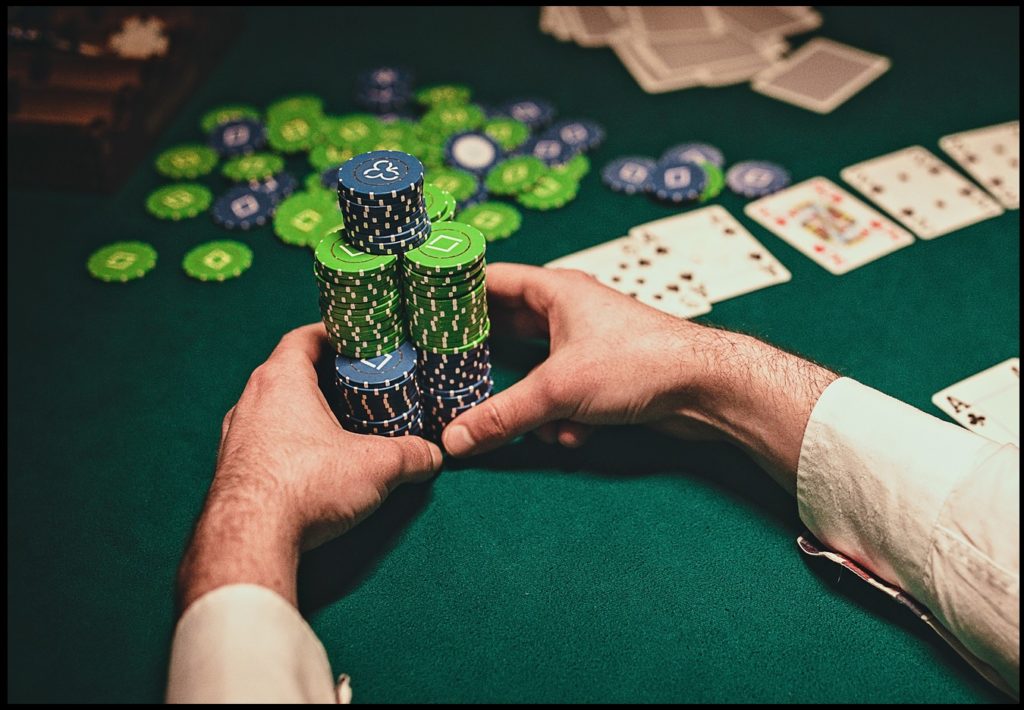
Although the sheer number of possible situations post-flop do make it a difficult art to master without the right method.
There are 1755 distinct flops (see the table below for the full breakdown), then stack sizes and range match-ups to consider. This makes just determining the best approach to take no easy task.
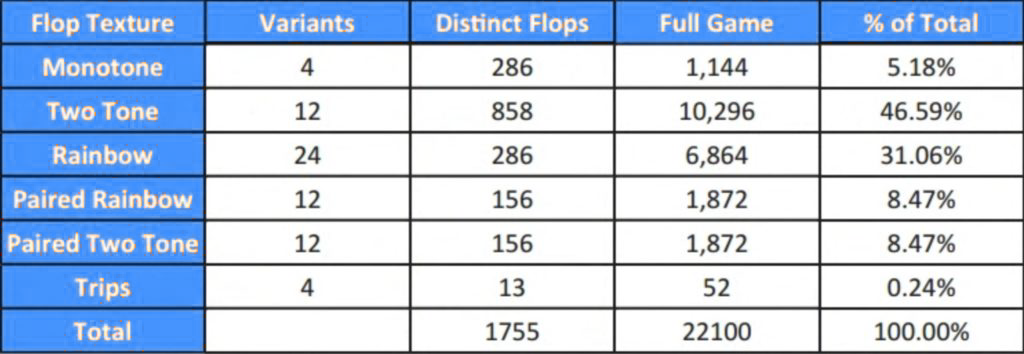
Approaches to Bet Sizing
The concept of bet sizing has certainly evolved significantly in the last few years. This is mostly due to GTO solvers becoming more widely used.
Having said that, there's still a significant percentage of poker players that use a more feel-based approach. These are typically old school players and their play generally leaves them labeled by their opposition as fish. Although, a few highly intelligent players have managed to make it work.
Typically, what you can expect at the table are players putting opponents' on a range to some degree. In some cases, reeling off combinations of hands their opponent may have. This sort of process is demonstrated in the following video.
[embedyt] https://www.youtube.com/watch?v=J6pZ0O0Irk8[/embedyt]At the highest level, the most common approach taken by the elite involves study and memorization.
Firstly, flop textures are sorted into groups so they become easier to study. A GTO solver is then used to explore a group until bet sizing patterns are discovered.
For example, let's say the button raises and BB calls (check out this article for more on playing from the big blind), how would a solver play in this situation across the low monotone board textures at 50bbs (M20) deep shown below?
6♥ 5♥ 4♥
2♥ 3♥ 5♥
8♥ 4♥ 2♥
QUESTION: Why would the in-position player increase their checking frequency as the board gets more connected?
Even exploring something as similar as low monotone flops, we can observe significantly different GTO strategies. In this instance, the more connected the board the higher the frequency of checking from the IP player.
This is mostly due to the connectedness diminishing the value of some of IP's holdings, like overpairs, as it potentially provides the big blind with more straights, 2 pair, and combo draws.
GTO solvers and bet sizing
We can see from the results generated in PIOSolver below that the checking percentage increases significantly as the flop becomes more connected (pot is set to 5bb, so bet 1 would be a 20% PSB (pot-sized bet), bet 3 is 60%, and bet 5 is a pot-size bet).
6♥ 5♥ 4♥

2♥ 3♥ 5♥

8♥ 4♥ 2♥

Elite players would often then continue drilling down further to explore the best strategy to use across a range of disconnected and connected low monotone flops. Remember, this is just low monotone flops BTN vs BB at 50bbs!
Clearly the amount of work necessary to generate data from a range of flops, positions, stack sizes, then the effort involved to learn from the information and implement it at the table is a challenge, to say the least.
For those that have managed to climb the mountain, you sometimes hear them say "my hand does this", as they make an action. Basically, they have studied a similar situation and can bet automatically without much thought required. Like a GTO bot!

GTO or an exploitative style?
Players using a more memorized GTO approach do need to be careful. If they operate overly automatic they may miss opportunities to exploit opponent weaknesses.
For example, betting larger than GTO suggests is going to be more profitable against a calling station. Fortunately, our 3-step system takes into account the opponent and actually starts by examining their range.
An Easy 3 Step System
An easy way for those looking to consistently bet a good size is to follow a few general rules of bet sizing. A lot more practical than trying to memorize 1000’s of GTO solutions!
We said determining a good bet size involves considering how the board texture interacts with each player's range. This means by applying a step-by-step thought process to assess villains' range, our range, and the board, we’re able to reach some assumptions in a hand that we can then use to formulate an effective bet size, or, multiple sizes to use.
An efficient way to think of a player's range is to group the sorts of hands in the range into equity buckets. These equity buckets can be created as follows;
- Strong hands (>75% equity in the hand)
- Moderate hands (50%-75% equity in the hand)
- Weak hands (33%-50% equity in the hand)
- Trash hands (<33% equity in the hand)
Using these groups provides a way to quickly visualize and assess an opponent's range. This is the first step in finding the right bet size/s to use. It should come fairly naturally with a bit of practice for those who aren't already thinking in this way.
STEP 1: What's our opponent's equity bucket distribution?
Let’s look at a spot where we're playing heads-up at the end of a tournament. As the player IP (small blind) we raise and the big blind calls. The dealer spreads a K82 flop, as you see here in this Michael Addamo (OOP) vs Justin Bonomo (IP) confrontation.
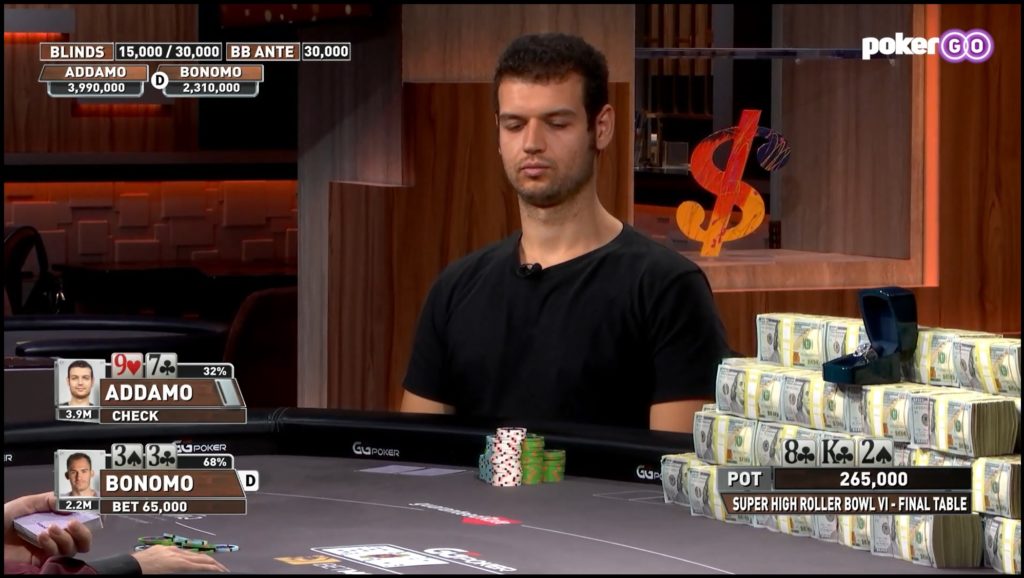
Consider how Addamo's OOP range (displayed below on the right side) connects with this board. Do this according to trash, weak, moderate and strong holdings (as shown in the bullet points above).
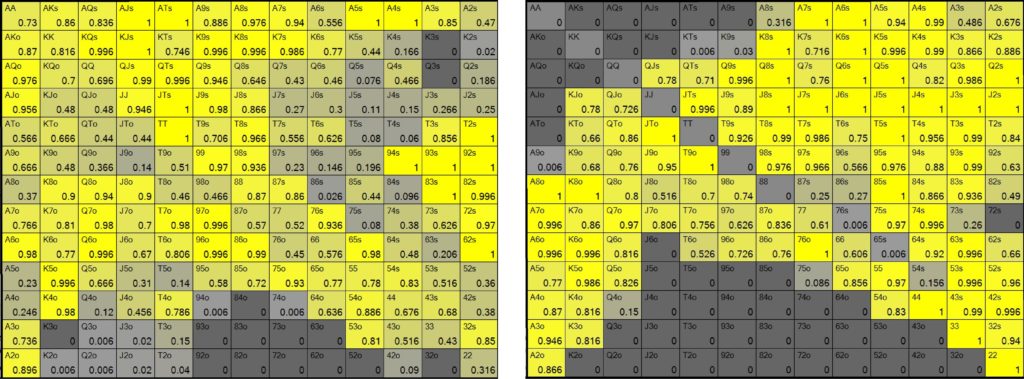
A look in PIOSover's range viewer below reveals over 40% of the time the OOP will have a trash hand. However, OOP will have a moderate holding or better, including a flush draw or middle pair plus, around one-third of the time. Accounting for another large chunk of villain's range.
At this point, we've probably covered enough of the big blind's range to take the next step in building our strategy.
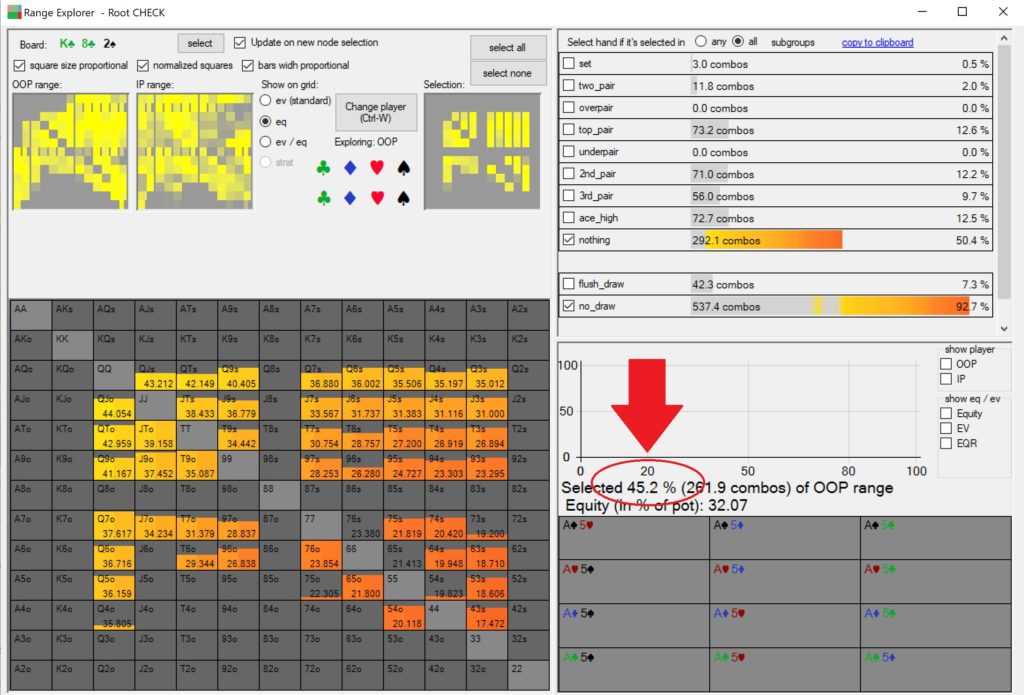
STEP 2: What bet size/s can we use to pressure the largest portion/s of villains range (indifference points)?
When choosing a bet size, it's often useful to shoot for a size that's close to an ‘indifference point’ as part of a good strategy. That is, choosing a bet size/s where lots of villains holdings will be mathematically close between a fold or continue (call or raise), from an EV perspective.
Trash equity bucket
For example, take the opponent's trash combinations, a small bet is extremely useful as it will force many of these weak hands into a tough spot. The small bet will still generate a decent number of folds but will also force players to defend with some marginal hands which in turn will lead to OOP generally again being in a difficult spot going into the latter streets.
Many players will be making significant mistakes in a spot like this. The most common is over-folding but some will continue too wide or too aggressively.
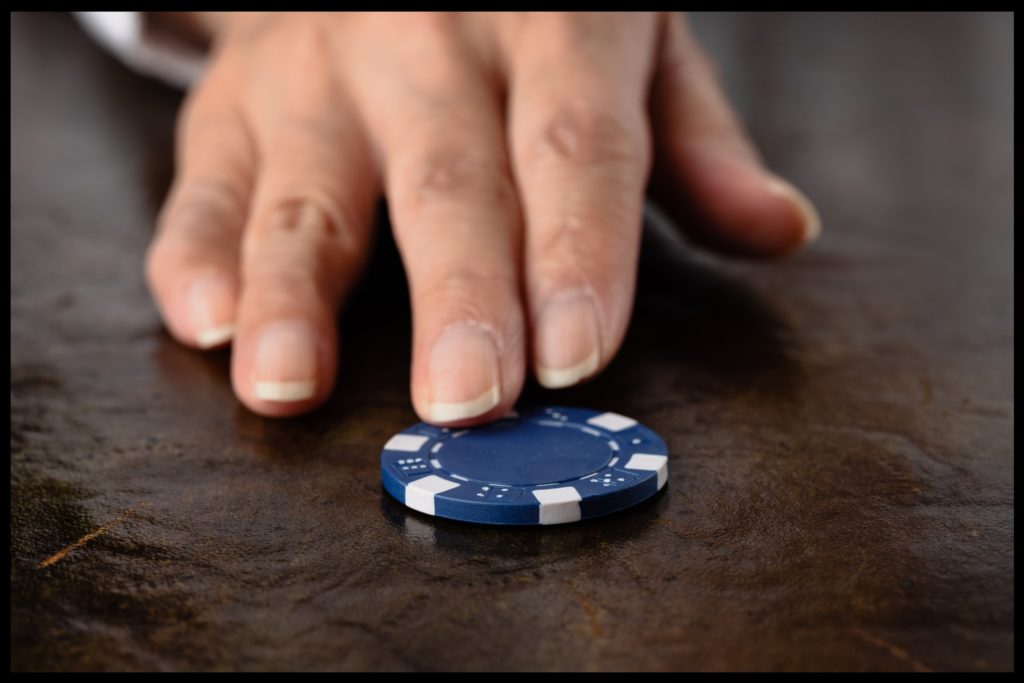
Moderate to strong buckets
When considering the other significant portion of villains range, middle pair or better and flush draws, these hands cope easily versus a small bet leading to fewer opponent mistakes, not to mention we’d be missing value with some of our better hands.
A larger bet versus this portion of the range would work well. We could do this with some of our stronger holdings that are mostly ahead to start building the pot. Then we’ll incorporate some of our best bluffs as part of a good poker strategy.
Betting frequency
When it comes to the frequency we want to bet, consider that middle pair plus and flush draws account for 1/3 of villains range. Moreover, we are raising with a wide range on the button. These points make it fairly obvious we wouldn’t want to c-bet a high % of the time. If we did, villain would be able to check-raise aggressively and blow us off a lot of our equity.
Betting around ½ the time feels about right, using a small 20% PSB ½ that time and the rest of the time a 60% PSB.
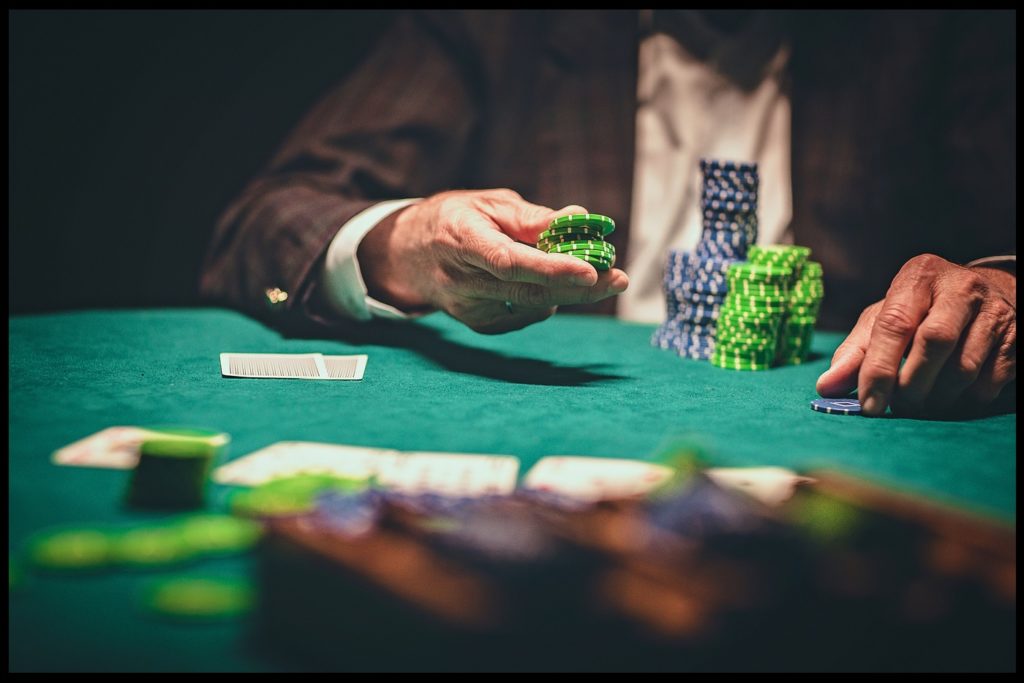
We’ve quickly created a strategy that would work really nicely given our opponent's range interaction on this flop texture.
Finally, before we commit to the strategy let’s consider our range and think about how we could split our hands between check, small bet, and bigger bet.
This will help us confirm we can profitably proceed with this betting plan.
STEP 3: Take into account our own equity bucket distribution and think about how we can group our hands for maximum efficiency.
As the button player here, we have the range as well as nut advantage on this K82 flop. Remember, the big blind only called and didn’t 3-bet preflop. In other words, IP has the best Kx, more set combinations, as well as aces, etc. This should give us the flexibility to target OOP’s range as we planned.
If for example, the flop was 567, well now they'd be no clear advantage since the big blind can connect favorably with this type of flop. Although, we would still have an overpair advantage and sometimes want to bet. So I'd only bet something like 1/3 of the time, using a 2/3 pot-size bet.
Some flops, turns, or rivers at times may be a challenge to determine the best bet sizes to use. In many instances, settling on a single size may make it easier. So for example, on our K82 flop, opting to bet 40% pot ½ the time is a fine solution.
However, I'd be looking to squeeze out a little more EV in this spot, not to mention be a little less predictable. So implementing the strategy of using the 2 bet sizes ½ the time on this flop texture is a great way to proceed in the hand. Really testing villain with a large portion of their range which often leads to considerable errors, boosting our win rate.
We just need to be sure we’re using the right hands when it comes to the strategy we’ve selected. In this case, the actions are check, 20% PSB, and 60% PSB actions.
Which hands in our range should check, bet small, or bet big?
This should be somewhat intuitive, but for those newer to the game, spending some time looking at solver solutions would definitely help you to learn to accurately build the right ranges. For a full breakdown of solvers and if they are worth it, check out this article, GTO Poker Solver: Should You Use a Program Like PioSolver in 2022?
So for example, we could bet bigger with aces because they don’t block any of villain's strong holdings that might give us action, especially the top pair portion of their range. At the same time, aces block the Ax combos that might call a small bet, further indicating this part of our range should be in the bigger bet category.
Let’s consider a few more hands and how we might play them according to our betting strategy. What would we do when we're holding hands like QQ, 33, QJ, or 34?
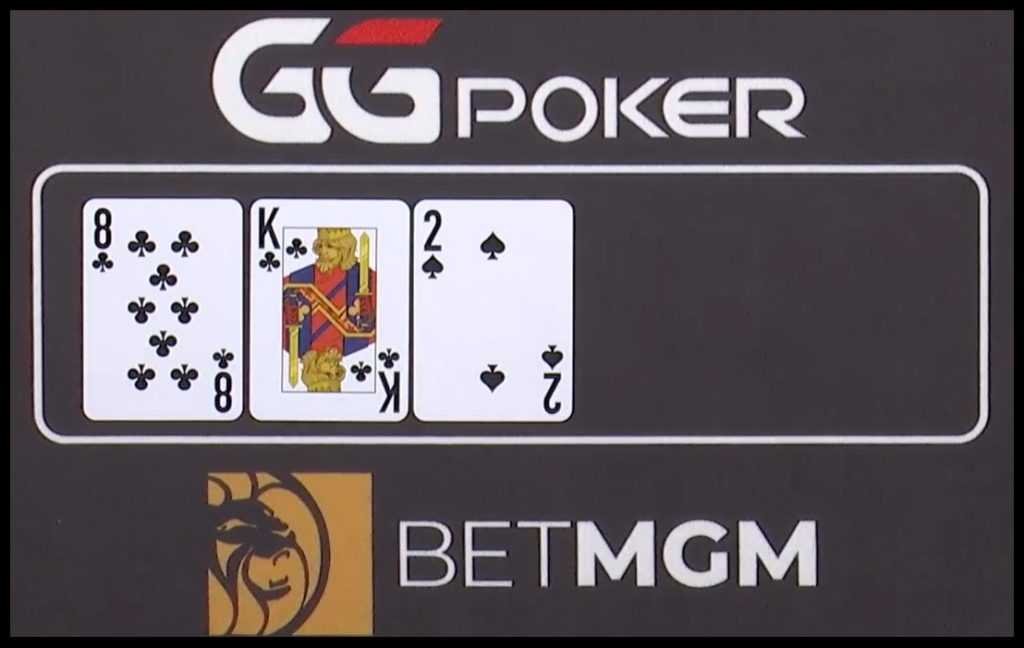
Bet or check QQ, 33, QJ, 34?
QQ wouldn’t want to bet big, since we’d be narrowing villains range to stronger hands like Kx. Moreover, QQ needs little protection so it would work well as a check or perhaps occasionally using a small bet. 33 benefits from protection but is a weak holding. With this combinaton occasionally betting small with for thin value but frequently checking it makes sense.
The same could be said with a hand like JQ. It could be best, but not a lot is gained by betting since only a few worse hands should theoretically be calling. So mostly checking this combination is the way to go.
When it comes to what we would consider a bluff portion of our range, good players use the key 3 bluffing criteria. This is a simple, logical approach to finding the best bluff combinations in our range and is outlined below.
The Three Rules of Efficient Bluffing
- Betting will fold out superior holdings
- The combination has some backdoor potential to become strong
- Blocks parts of villains continuing range
A hand like 34 would work really well as part of our semi-bluffing range. Consider the points above, firstly, 4 high is currently the weakest raw equity hand possible so whenever we bet and get a fold it’s a huge plus and a mistake by villain with any hand if they could see our cards.
Secondly, 34 has some backdoor potential since running A5 and 56 give us super strong hands.
Next considering the 3rd point, blockers, 34 with a club helps to block villains continuing flush range (plus boosts our equity a little). Therefore betting it more often with a club in our hand is a good strategy.
As for the sizing, as is often the case with GTO, we could mix between the smaller and bigger size. Some players are hesitant to use small bets with hands we’d consider bluffs, but keep in mind that smaller bets keep our opponent's range wide which sets up really profitable barrelling opportunities.
This is an aspect many recreational players fail to consider when it comes to utilizing smaller sizes.
Forcing an opponent, especially if they are OOP to continue with a really wide range creates great opportunities on later streets. So trying to take down the pot instantly with a big bet isn’t always necessarily the way to go. Furthermore, this helps to keep our range more balanced, making us tougher to play against.
Example Hand - C-betting the flop
The 3-step system will come naturally after some practice. Moreover, in no time at all, you'll start to detect patterns that will help you quickly lock on to the best bet size/s to use.
Take the average flop when it's a UTG raiser versus the big blind defender for example (shown below). We can see from the pie charts with the equity buckets below that IP generally has a huge advantage. This allows the UTG player to generally c-bet at a high frequency, often using a small size. The big blind may be defending with something like 44% of hands while the UTG player only opens with 15% of hands so it's a predictable pattern.
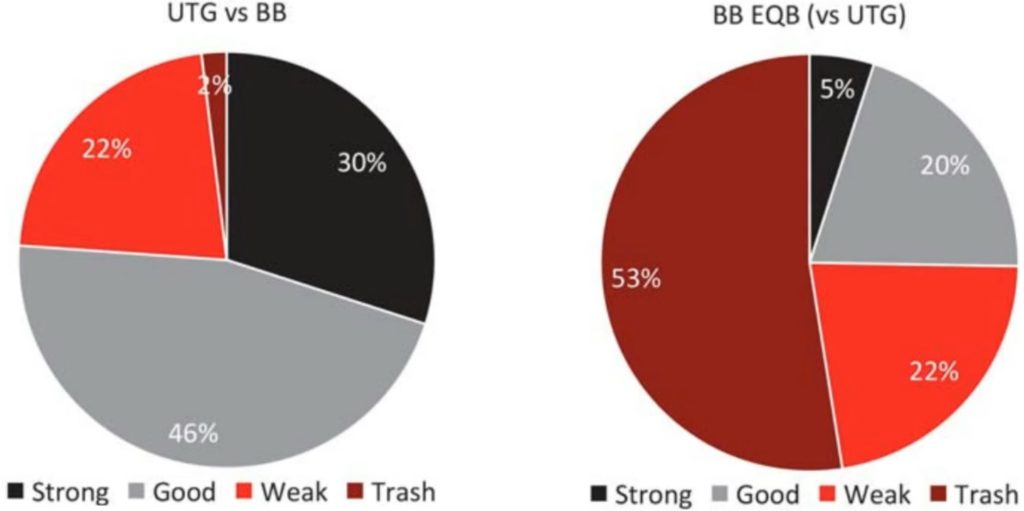
QUESTION: There are still flops when UTG would have to be cautious, can you think of what flop textures this may include?
Mid-connected flops fit well with big blinds defending range, so this is a texture where the UTG player won't be c-betting a lot. In fact, these boards are so favorable for the big blind that they can implement a donk betting strategy. Donk betting as much as 70% of the time on a 567 flop. Donk betting is an awesome strategy you can learn from our article series starting with Learning How to Donk Bet the Flop in NLH (Donk Betting Strategy Series P1).
Board texture plays a pivitol role
Compare the above equity buckets to below which shows the average equities on a 654r flop and an A76r flop.
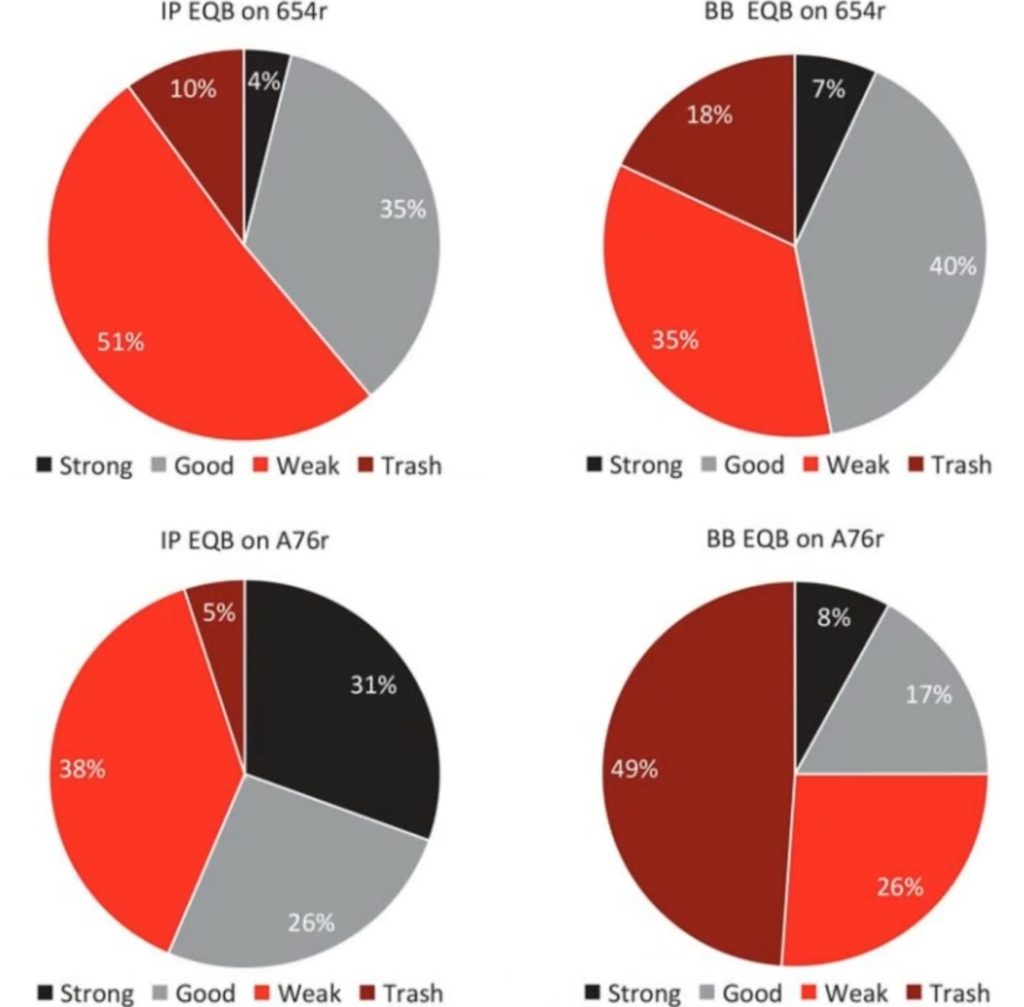
We can see the big blinds good hands are massively reduced on the ace-high board. Their trash equity bucket is also hugely increased. This means the IP player enjoys a big advantage on the ace-high board. The result is them being able to use an aggressive c-betting strategy, unlike on the 456r board, where the BB has the strong hand edge.
Hopefully, for those new to equity buckets, the examples we've looked at have enabled you to get a clearer idea of the concept. It really is a great way to visualize ranges so we can quickly assess them and formulate a strategy. Let's try this now!
Challenge Hand!
Imagine you raise on the button with a 40bb stack and the big blind defends. How would you proceed on the following flop?
J♠ 6♥ 6♦
The GTO ranges look as follows.
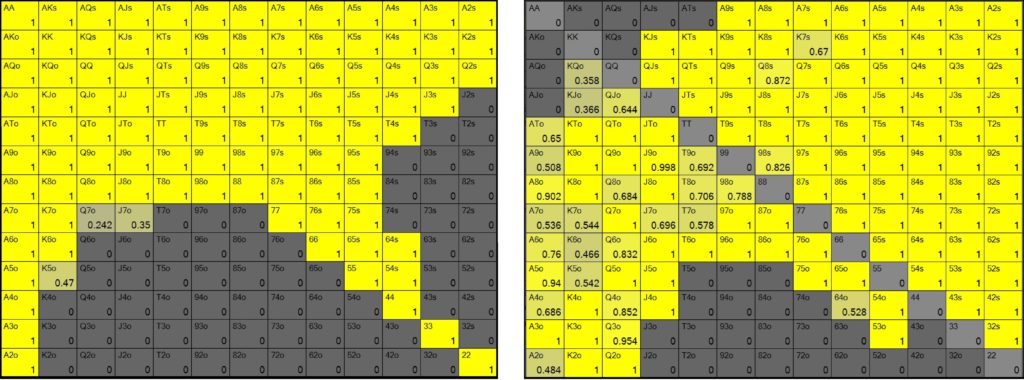
For those keen beans, go ahead and draw the equity buckets on a piece of paper before reading on.
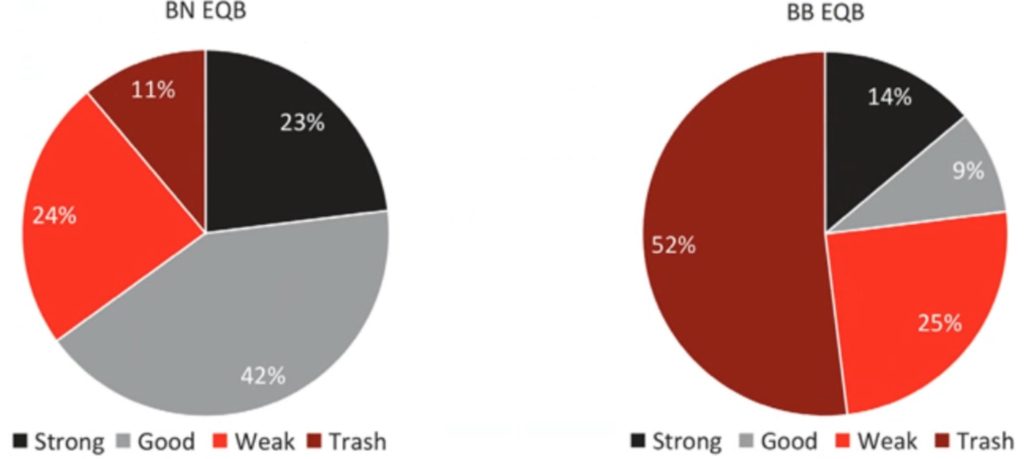
STEP 1
Two things really stand out about the big blind's range. Firstly, they have a huge percentage of trash hands on this flop. Secondly, they do actually claim a nut advantage in this spot since they have more 6x than the button player.
STEP 2
A small bet by the button player will be really useful in this situation. It provides a lot of pressure to a considerable portion of the big blind's range. The smaller bet also means the button player loses less when the big blind leverages their nut advantage with a check-raise, forcing the button to fold their weaker c-bets. This ability to leverage a nut advantage means we can't overdo it with the c-betting. Something like 1/2 - 3/4 of the time feels about right.
STEP 3
Generally, when we c-bet, we'll be favoring either the strongest or weakest hands more than mediocre strength hands. Mediocre strength hands really suffer from being check-raised and are put in a tough spot whilst trash hands are easy to let hit the muck.
GTO will still be doing a lot of mixing but we can see this pattern in the first diagram below. Then following that is a diagram showing the button players c-betting strategy by hand class.
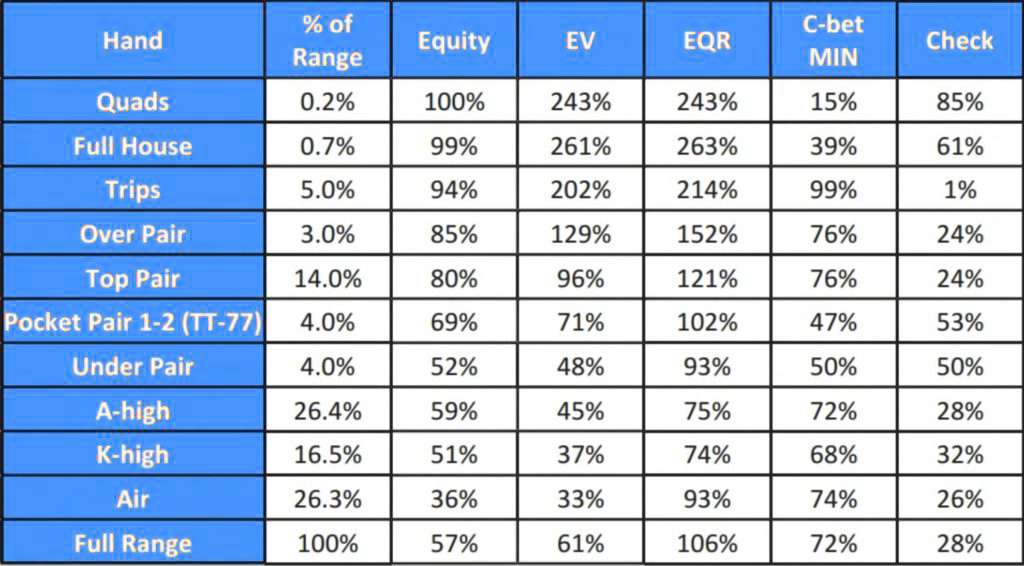
Below is a solid GTO strategy generated from PIOSolver.
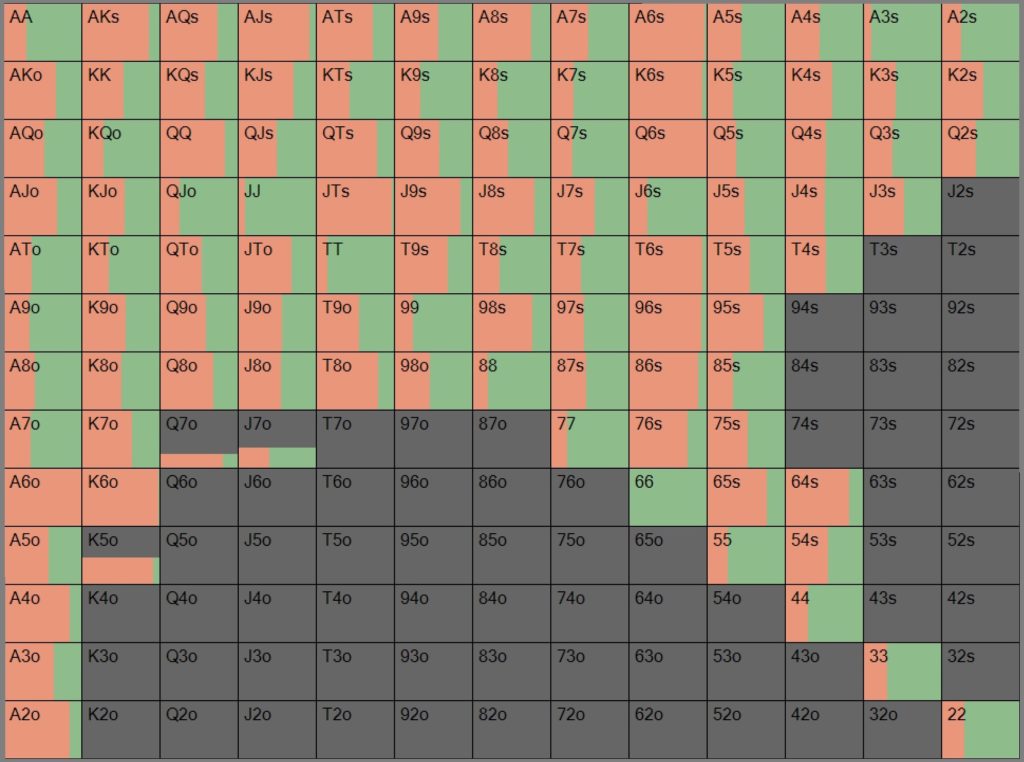
We can see from the matrix above, value bets mostly include trips and Jx. Notice some of the jacks that are moderately strong but don't mind a little protection bet more (J9, etc) than a hand like KJ. AA makes a good check since it needs little protection and TT likes to check too to keep the opponent's range wider so it can then bluff catch or potentially value bet depending on the board run-out.
We can see a ton of mixing from the solver but mostly shoot for the 3 rules of efficient bluffing when it comes to betting with weaker combinations (semi-bluffs).
Hands like 45,79 and 8T that can back into straights, and additionally flushes if suited, make great betting candidates. As is QT which wraps around the jack and has an over card. Finally, as mentioned, some weak combinations we have no problem bet folding (like T4) can be mixed in at a frequency.
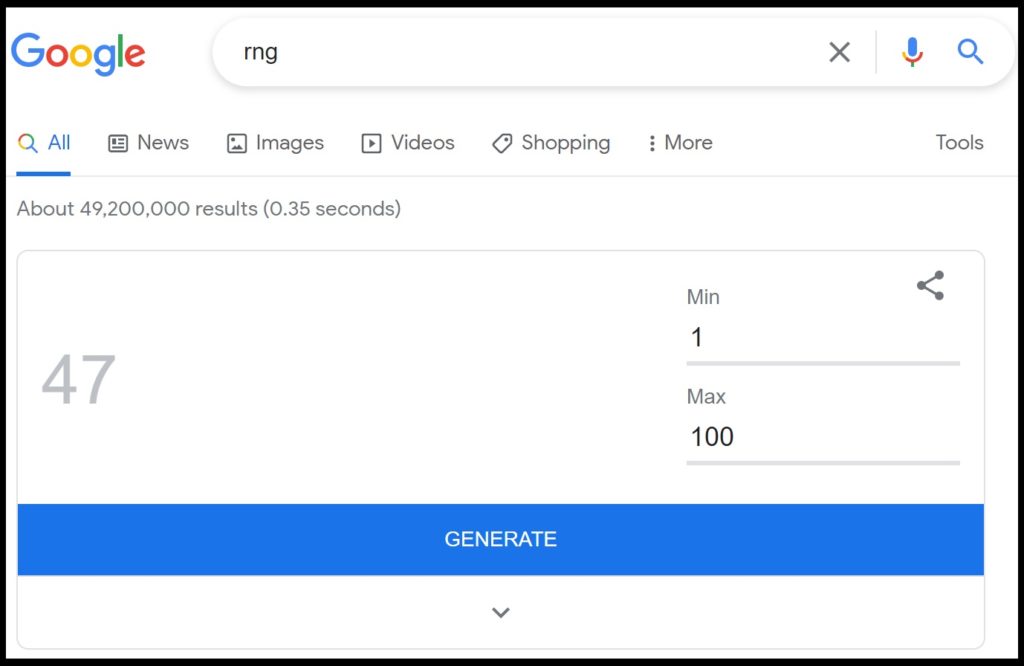
Consistently make better decisions than your opponents
Keep in mind the idea isn't to mimic GTO, that's impossible. We simply want to be making better decisions than our opponents.
Following the tips discussed and using the combinations above allowed us to quickly build a really good betting strategy. This skill will provide you with an edge at the table and boost your win rate.
Against some players who you have information on, it may be that you favor an exploitative style but GTO will always be there to serve you as an excellent guide even when you aren't looking to implement it exactly.
Here are some interesting hands analyzed in the video below. Take a moment at each flop to apply the 3-step process and decide how your strategy would perform.
[embedyt] https://www.youtube.com/watch?v=Ycv93Bam76E[/embedyt]
Conclusion
By using the 3-step process to betting we've seen we're able to quickly come up with some great betting plans. With a little practice, following these steps will allow a cognitive player to consistently make good decisions on the fly. A skill of huge importance that's going to imprint on your success at the tables.
For those who struggled with any concepts in this more advanced article, be sure to check out our MTT poker course so you can learn to master the latest strategies and win more at the tables. For more on equity buckets, the excellent book Modern Poker Theory, which we'd also like to credit for parts of this article, would be an excellent read and can be purchased here.
Good luck at the tables as you work on and refine your 3-step process, allowing you to dominate the competition!




